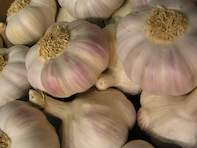Crop Rotation
It is advisable to practice crop rotation as this limits the build-up of pests. Brassicas (for example cabbages or mustard) or tomatoes work well but avoid planting other alliums and bulb crops that could be affected by the same pests or diseases that would affect garlic. If rotating is not possible then fumigation and more rigid crop protection protocols should be practiced.
Yield (tonnes per hectare)
Conservative: 8 tonnes Average: 10 tonnes Good: 15 tonnesHarvesting
Harvesting of garlic is normally five to six months after planting. As the harvest time nears, the leaves will begin to droop and brown from the tips and start to die back. When about 50 percent of the leaves have died back the garlic can be harvested. Harvesting can be done by hand or by mechanical harvester.
The garlic bulb has to first be loosened from the soil. In the case of the manual process, a fork is used to loosen the soil around the bulb and the bulb is lifted free without breaking the stem, as this will shorten shelf life and expose the garlic bulb to diseases and hasten dehydration. Mechanical harvesters do the same process only much faster.
Once harvested the garlic must be cured by placing in well ventilated bins or hanging in bundles in cool, well ventilated areas. After a few days the leaves and roots are trimmed from the bulb and the garlic is sent for grading and storage.